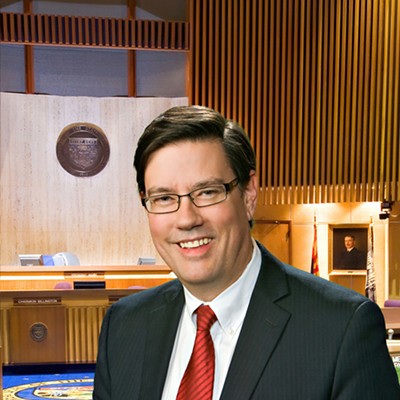If you've ventured into the downtown moonscape lately (do it—it's not that bad), you may have noticed rails being laid for the streetcar. Or maybe you monitor the cheerleading updates that trumpet this progress. Regardless, it's happening, and it won't be long before Congress Street opens again.
That has some folks wondering what'll happen—and what should happen—when it does. I was pleasantly surprised to see Mayor Jonathan Rothschild stick his head up out of the trench recently and declare his support for keeping part of Congress Street closed to vehicular traffic—thereby transforming it into a pedestrian space.
How refreshing to have a mayor who's willing to lay out a progressive vision on such things. Our last mayor stuck his head out of his burrow a couple of times a year like a desert groundhog, just long enough to cut a few ribbons, see his shadow and declare himself mayor for another six months.
Closing Congress to cars is an idea I've raised repeatedly. Many other cities around the West have created such a space—a pedestrian destination clustered with shops, restaurants and entertainment opportunities, often linked to public-transportation hubs and light rail. In virtually every case, it works on several levels: as a boon to downtown businesses; as a built-in venue for parades, street fairs and other large public events; as a source of civic identity and pride; and as a place for cultural and artistic expression.
Tucson has all the necessary ingredients, so why don't we have one here? I can name that tune in three notes: No. Good. Reason.
Every time it comes up, somebody says, "It can't be done." Merchants fret about lost business, and engineers offer excuses based on their unswerving fealty to the automobile, while politicians cry poor and cling to the status quo as if it were political Kevlar.
Well, here's a great, big cowboy slap on Mr. Mayor's back for saying that not only can it be done; it should be done.
Think about it: Motorists have already learned to avoid Congress between Toole and Stone avenues. Keeping it closed would not introduce a sudden, problematic shift in traffic patterns. It's the perfect time to do it.
Moreover, adding the streetcar to the mix in this congested area seems like a recipe for disaster. Crossing the intersection of Broadway Boulevard, Toole, Fourth Avenue and Congress Street already approximates a game of Frogger: Will the cute little pedestrian froggies make it across, or will they be crushed by the speeding SUC (Society-Undermining Cargoship)?
Vehicles barrel around the blind curve from Broadway into the extremely narrow lanes of Congress, where the adjacent sidewalks are often crammed with crowds of people spilling out of clubs and concerts. Throw in the streetcar and its passengers competing for the same narrow space, and it's a dangerous clusterfuck waiting to happen.
It needn't happen. There's simply no reason to maintain vehicle access to that section of roadway; never mind the jittery utterances of skittish merchants or transportation apparatchiks whose minds are locked inside tiny internal-combustion chambers.
I spoke with the folks at ParkWise and confirmed that only about 50 parking spaces would be sacrificed along Congress between Toole and Stone. Westbound Broadway traffic can be redirected into the fancy new Plaza Centro parking garage (375 spaces that have rarely been filled in the first year of its existence), or, if it insists on passing through, onto Toole.
And here's a question for merchants: When was the last time a vehicle came into your shop and slapped down a credit card? It's about people, people! It's about creating a pleasant, exciting, energetic space in which people can gather, shop and party—and then wander into your place without even knowing it existed until that moment.
It's absolutely not about making the world more convenient for cars. We've been doing that for a century now, and it's killing us—literally killing our planet, eroding the social fabric of our communities, poisoning our politics and foreclosing on good ol' American ingenuity and innovation.
Oh, but there's no money for it, right? We're throwing down $200 million on this streetcar, yet we're to believe there's not another measly $1 million available to make a safe, pleasant and interesting destination for it? Bollocks.
I envision the mayor taking the first ceremonial ride from campus to downtown and stepping off the streetcar into a full-on block party on Congress, without a single automobile or billow of exhaust in sight. Now that's the kind of progress I can raise a glass to.





